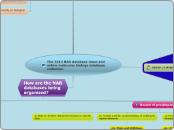The 2013 NAR database issue and online molecular biology database collection
GROUP 14 MEMBERS
AUDREY LAU CHIEW LANG
AQ100035
CHOW YI WEN
AQ100041
NG CHEE CHING
AQ100058
SOONG JIA XIN
AE080293

NAR: Nucleic Acids Research
NAR: Nucleic Acids Research
An Open Access journal
Free for retrieval
NAR's Top Articles are updated monthly
Showed recent articles that have been most often accessed in the specified month and category
HTML
NAR's Featured Articles represent the top 5% of papers
in terms of
originality
significance
scientific excellence
NAR's F1000 Articles: the Faculty of 1000 (a post-publication peer-review service that provides online evaluations of recently published research articles) provides evaluation and ratings of highly significant research articles
Has been identified by the Special Libraries Association (SLA) as one of the top 100 most influential journals in Biology and Medicine over the last 100 years
Organise the online database mostly on biological and bioinformatics field.
How are the NAR databases being organised?
Major database categories
Structure databases
RNA sequence databases
Protein sequence databases
Nucleotide Sequence Databases
Genomics Databases (non-vertebrate)
Metabolic and Signaling Pathways
Other Molecular Biology Databases
Microarray Data and other Gene Expression Databases
Human and other Vertebrate Genomes
Human Genes and Diseases
Proteomics Resources
Organelle databases
Plant databases
Cell biology
Immunological databases
Number available
In 20th annual Database Issue (2013), 176 articles included.
88 new online databases
77 update articles on databases formerly covered in NAR Database Issue
11 update articles that have been previously presented in other journals
1512 online databases up to date, sorted into 15 categories and 41 subcategories
Timeline for database development
In April 1991, NAR had 18 articles whereas in May 1992, it had 19 articles. Types of articles in general:
i) Medical genetics database (Haemophilia B)
ii) Nucleotide sequence databases (GenBank, EMBL Data Library)
iii) Protein databases
Eg: SWISS-PROT, PIR, PROSITE, Restriction Enzyme Database (REBASE), Transcription Factors Database (TFD) and Histone database
On July 1, 1993, the NAR supplementary issue was officially named as the Database Issue. Total of 24 articles included:
i) ENZYME database
ii) RNA and protein structure databases
In year 2012, main highlight of databases were:
i) Human proteins
ii) BioSample databases
iii) Principles of NCBI Taxonomy Database
iv) Gene Ontology and UniProt Gene Ontology Annotation projects
Trend observed was focused on small molecules and relevant topics.
In year 2013,emphasis of databases are on:
i) Mechanisms of protein–ligand binding
ii) Basis of human disease, potential drugs and their targets
iii) Genomic and RNAseq data for monkeys (comparative genomics purpose)
Availability of genome data enables research on improving human health.
Reason of grouping databases
a) Able to retrieve related information in shorter time
b) Provide a better understanding of eukaryotic repeat elements
eg: Dfam and SINEBase
c) Provide relevant information for research on disease fighting particularly for cancer
eg: UCSC Cancer Genome Browser, Atlas of Genetics and Cytogenetics in Oncology and Haematology and the TP53 website
d) Databases under the same topic allows comparisons and deciding on the more reliable predictions
Reason of some databases are not longer in the databases and dropped from it
a) Unresponsive and outdated websites
b) Budget constraints. Eg. ExDom database charges its users
c) Replaced by more updated and encyclopedic databases
d) Overlapped with other publication

Criteria for selection
a) Database has large scope of coverage
b) Offers guarded first hand data together with user friendly search tools
c) Focus is on the usefulness of the database for NAR users
d) "Boutique" databases will be selected if the topics covered are of general interest
e) Open for submissions from good review and established databases in future
f) Paper submitted was not published elsewhere unless under special conditions
g) Only update papers from most popular databases are accepted. Other databases require significant new developments to be qualified for publication
Reason of databases are created and shared
a) Better understanding of the genomic data which allows biomedical experts use it to treat human disease.
b) Easy way to access and cross reference between different databases
c) Consistent improvement of existing databases
d) Partnership allows handful of data for exchange which leads to wide coverage and effortless data management
